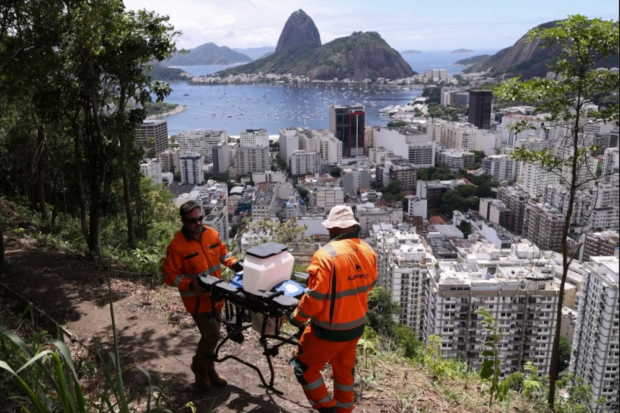The city of Rio de Janeiro is taking innovative steps to combat the effects of recent heatwaves and accelerate the recovery of degraded urban green spaces. In a groundbreaking pilot project, French startup Morfo’s drones will be utilized to reforest hard-to-reach areas, specifically targeting Floresta da Posse in Campo Grande.
With traditional reforestation techniques proving time-consuming and costly, Rio de Janeiro is leveraging Morfo’s cutting-edge technology to revolutionize the process. By utilizing drones, large areas can be mapped and reforested within a matter of weeks, a speed that is up to 50 times faster than traditional methods.
One of the most significant advantages of Morfo’s technology is the wide range of native species that can be used during the reforestation process. At least 20 different species can be planted, reducing costs by up to five times when compared to traditional methods. The use of pre-germinated seed capsules eliminates the need for cumbersome nurseries and reduces delays caused by waiting for seeds to grow into seedlings. Morfo’s drones can be loaded with thousands of capsules, launching them at a rate of 180 per minute, following a predetermined planting pattern that only drones can accurately implement.
Beyond the immediate benefits of accelerated reforestation, this project also signifies a digital transformation for the areas in Rio that require reforestation. Digitizing the areas not only allows for better monitoring of the reforestation process but also aids in planning future actions. The data collected through this project will serve as a valuable resource for Rio’s ongoing efforts to restore the balance in its urban green spaces.
Although the positive impacts of this initiative may take between two to five years to fully materialize as new trees grow, the investment of BRL 27,000 by the municipal government demonstrates their commitment to combatting urban deforestation and mitigating the effects of heatwaves. Rio de Janeiro’s embrace of drone technology and the use of native species showcases a forward-thinking approach to reforestation that is both efficient and environmentally conscious.
FAQ:
Q: What is the purpose of using drones in reforestation?
A: Drones are being used in reforestation to accelerate the process and reach hard-to-reach areas.
Q: How fast can drones reforest areas compared to traditional methods?
A: Drones can reforest areas up to 50 times faster than traditional methods.
Q: What is the advantage of using Morfo’s technology?
A: Morfo’s technology allows for the use of a wide range of native species, reduces costs, eliminates the need for nurseries, and has a faster reforestation rate.
Q: How many seed capsules can Morfo’s drones carry and launch?
A: Morfo’s drones can be loaded with thousands of capsules and launch them at a rate of 180 per minute.
Q: Why is digitizing the reforestation areas important?
A: Digitizing the areas allows for better monitoring of the reforestation process and aids in planning future actions.
Q: How long will it take for the positive impacts of this initiative to fully materialize?
A: The positive impacts may take between two to five years to fully materialize as new trees grow.
Q: How much did the municipal government invest in this project?
A: The municipal government invested BRL 27,000 in this project.
Definitions:
1. Reforestation: The process of replanting trees in a forest or woodland area that has been cut down or destroyed.
2. Native species: Plants that naturally occur in a particular region or ecosystem.
3. Pre-germinated seed capsules: Capsules containing seeds that have been partially germinated, eliminating the need for growing seeds into seedlings.
4. Urban deforestation: The removal or destruction of trees and vegetation in urban areas.
Source: ISP Today

